|
Ephesians Bible Study by David Ahl ~ www.BibleStudyMen.com |
 Help build a house for a
Help build a house for aneedy family in Guatemala. |
Ephesus was the most important city in western Asia Minor (now Turkey). It had a harbor that at that time opened into the Cayster River, which in turn emptied into the Aegean Sea. Because it was also at an intersection of major trade routes, Ephesus became a commercial center. It boasted a pagan temple dedicated to the Roman goddess Diana (Greek Artemis), cf. Acts 19:23-31. Paul made Ephesus a center for evangelism for about three years, and the church there apparently flourished for some time, but later needed the warning of Rev 2:1 -7.
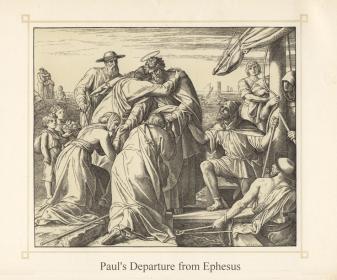 Paul leaving Ephesus by Julius Schnorr von Carolsfeld |
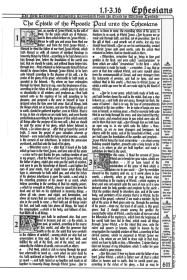 Tyndale Bible (MSTC), 1535 |
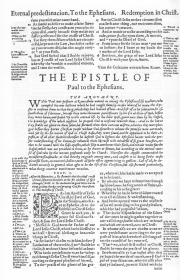 Geneva Bible, 1560 |
 Great Bible, 1540 |
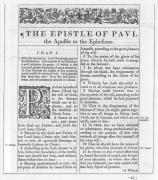 Original King James Version, 1611 |
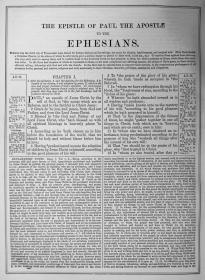 John Brown Commentary, 1870 |
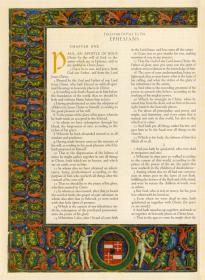 KJV, 1769, printed 2000 |
Theological Message
Unlike several of the other letters Paul wrote, Ephesians does not address any particular error or heresy. Paul wrote to expand the horizons of his readers, so that they might understand better the dimensions of God’s eternal purpose and grace and come to appreciate the high goals God has for the church.
The letter opens with a sequence of statements about God’s blessings, which are interspersed with a remarkable variety of expressions drawing attention to God’s wisdom, forethought and purpose. Paul emphasizes that we have been saved, not only for our personal benefit, but also to bring praise and glory to God. The climax of God’s purpose, “when the times will have reached their fulfillment,” is to bring all things in the universe together under Christ (1:10). It is crucially important that Christians realize this, so in 1:15-23 Paul prays for their understanding (a second prayer occurs in 3:14 -21).
Having explained God’s great goals for the church, Paul proceeds to show the steps toward their fulfillment. First, God has reconciled individuals to himself as an act of grace (2:1-10). Second, God has reconciled these saved individuals to each other, Christ having broken down the barriers through his own death (2:11-22). But God has done something even beyond this: He has united these reconciled individuals in one body, the church. This is a “mystery” not fully known until it was revealed to Paul (3:1-6). Now Paul is able to state even more clearly what God has intended for the church, namely, that it be the means by which he displays his “manifold wisdom” to the “rulers and authorities in the heavenly realms.” (3:7-13). It is clear through the repetition of “heavenly realms” (1:3,20; 2:6; 3:10; 6:12) that Christian existence is not merely on an earthly plane. It receives its meaning and significance from heaven, where Christ is exalted at the right hand of God (1:20).
Nevertheless, that life is lived out on earth, where the practical daily life of the believer continues to work out the purposes of God. The ascended Lord gave “gifts” to the members of his church to enable them to minister to one another and so promote unity and maturity (4:1-16). The unity of the church under the headship of Christ foreshadows the uniting of “all things in heaven and on earth” under Christ (1:10). The new life of purity and mutual deference stands in contrast to the old way of life without Christ (4:17-6:9). Those who are “strong in the Lord” have victory over the evil one in the great spiritual conflict, especially through the power of prayer (6:10-20).
Author, Recipients
Traditionally. the letters to the Ephesians, Philippians. Colossians, and Philemon were assumed to have been written by Paul during his imprisonment in Rome (Acts 28:16-31), and were consequently called “captivity epistles.” The attribution of all of these to Paul, and the recognition that references to imprisonment and the imperial guard do not necessarily mean imprisonment in Rome because there were detachments of the emperor's guards at various places, have led most scholars to abandon this interpretation.
Despite the traditional title, therefore, and the references to sender and recipient in 1:1 (with further reference to the sender in 3:1), most scholars doubt that Ephesians is by Paul, and many doubt that it is in fact a letter. The similarity of this text to the letter to the Colossians, which is also of uncertain Pauline authorship, suggests a false attribution of authorship (known as pseudepigraphy); in addition, its theology and vocabulary do not reflect Paul’s concerns, especially in presenting resurrection as a current rather than a future event (2:1-2,6; cf. Rom 6:5-8, Phil 3:10-11). It mentions “heavenly places” (1:3, 20, 2:6; 3:10; 6:12) and speaks of Christ as “the head” of the church, which is “his body” (1:22-23; 4:11, 15-16), key theological expressions absent from the undisputed Pauline epistles. Nor does it deal with the relationship of the community to Torah, a major focus of Paul’s writings in Galatians and Romans.
The text’s connection to Ephesus is also problematic: the words “in Ephesus” (1:1) are absent from some of the best early manuscripts. Defenders of Pauline authorship argue that the letter was written late in Paul’s ministry for a different audience. Without the opening and closing sections (1:1-2 and 6:21-24), the letter reads more like a sermon or exhortation addressed to Christian communities in general, rather than a letter specifically dealing with the problems and concerns of one community in particular.
Bible Studies on Ephesians
I have arbitrarily divided the book of Ephesians into seven sections for discussion. I have found that in small groups (6 to 20 people) each unit takes about an hour to go through. You can give your group members the handout the week before or simply hand it out at the time of the study. The discussion questions are slightly different from traditional Bible studies in that they emphasize the application of the book to your life today. The Leader's Guides provide "answers" to most, but not all of the questions because many of the questions are designed to be a springboard to further discussion and there is no truly right or wrong answer. If you have questions or comments, please use the "Contact Me" button on the menu below. I guarantee that I will read your comments, however, as this web site gets more than 3,000 visitors per day, I can't possibly answer every one.
The PDF file for each lesson includes a page with the discussion questions, a page with the scripture verses [NIV, 1984], and several pages of notes for the leader.
- Ephesians-1:1-14 - Spiritual blessings in Christ.
- Ephesians 1:15-23 - Thansgiving and Prayer.
- Ephesians 2 - Made alive in Christ.
- Ephesians 3 - Paul, preacher to the Gentiles, Second prayer.
- Ephesians 4 - Unity in the Body of Christ, Living as children of light.
- Ephesians 5 - Living in the light, Wives and husbands.
- Ephesians 6 - Relationships: Children & parents, Slaves & masters, The armor of God.
| Click here for Complete Menu of Bible Studies and Christian Resources |
| United We Stand! | Jokes, Funny Cats | Inspirational Books | Meet Dave Ahl | Cool Links |
| Patriotic FDCs | Humor Books | Christian Investing | Scams Explained | Contact Me |
 |
|
|
|

|